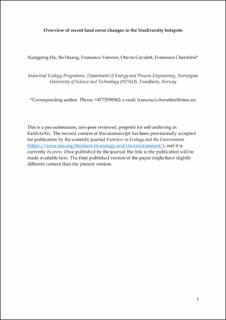| dc.description.abstract | Biodiversity hotspots are the most biologically rich, yet threatened, terrestrial regions. From 1992 to 2015, they underwent 148 Mha of land cover changes, including forest losses (56 Mha, of which 40 Mha caused by agricultural expansion), declines of shrubland or savannah (23 Mha), and urbanization (10 Mha). The three largest losses in forest areas occurred in Sundaland, Indo-Burma, and Mesoamerica, accounting for 11 Mha, 6 Mha, and 5 Mha, respectively. This corresponds to a relative loss of 13%, 6%, and 7%, respectively, of the forest area originally present in 1992. Forest losses are also observed inside protected areas within the biodiversity hotspots. About 4.5 Mha of forests were lost between 2000 and 2015, and around 1 Mha of losses happened in the relatively recent past (between 2010 and 2015). Stricter and more effective land-based policies are needed to preserve threatened ecosystems and prevent risks of massive species extinction. | en_US |
